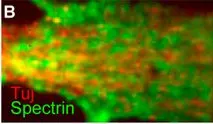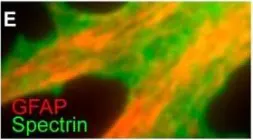The organ of Corti, located in the inner ear, is the primary organ responsible for animal hearing. Each hair cell has a V-shaped or U-shaped hair bundle composed of actin-filled stereocilia and a kinocilium supported by true transport microtubules. Damage to these structures due to noise exposure, drug toxicity, aging, or environmental factors can lead to hearing loss and other disorders. The challenge when examining auditory organs is their location within the bony labyrinth and their small and fragile nature. This protocol describes the dissection procedure for the cochlear organ, followed by confocal imaging of immunostained endogenous and fluorescent proteins. This approach can be used to understand hair cell physiology and the molecular mechanisms required for normal hearing. Key features • Protocol for the microdissection of the organ of Corti and suitable preparation for later immunostaining. • This technique involves the evaluation of mouse cochlea for planar-cell-polarity protein. • Quantitative and qualitative analysis of hair cell cilia in different dimensions.
©Copyright : © 2025 The Authors; This is an open access article under the CC BY license.
Product Citations: 36
Cochlear Organ Dissection, Immunostaining, and Confocal Imaging in Mice.
In Bio-protocol on 20 January 2025 by Chen, C., Chen, B., et al.
In eLife on 12 November 2024 by Ono, K., Jarysta, A., et al.
Otolith organs in the inner ear and neuromasts in the fish lateral-line harbor two populations of hair cells oriented to detect stimuli in opposing directions. The underlying mechanism is highly conserved: the transcription factor EMX2 is regionally expressed in just one hair cell population and acts through the receptor GPR156 to reverse cell orientation relative to the other population. In mouse and zebrafish, loss of Emx2 results in sensory organs that harbor only one hair cell orientation and are not innervated properly. In zebrafish, Emx2 also confers hair cells with reduced mechanosensory properties. Here, we leverage mouse and zebrafish models lacking GPR156 to determine how detecting stimuli of opposing directions serves vestibular function, and whether GPR156 has other roles besides orienting hair cells. We find that otolith organs in Gpr156 mouse mutants have normal zonal organization and normal type I-II hair cell distribution and mechano-electrical transduction properties. In contrast, gpr156 zebrafish mutants lack the smaller mechanically evoked signals that characterize Emx2-positive hair cells. Loss of GPR156 does not affect orientation-selectivity of afferents in mouse utricle or zebrafish neuromasts. Consistent with normal otolith organ anatomy and afferent selectivity, Gpr156 mutant mice do not show overt vestibular dysfunction. Instead, performance on two tests that engage otolith organs is significantly altered - swimming and off-vertical-axis rotation. We conclude that GPR156 relays hair cell orientation and transduction information downstream of EMX2, but not selectivity for direction-specific afferents. These results clarify how molecular mechanisms that confer bi-directionality to sensory organs contribute to function, from single hair cell physiology to animal behavior.
Emx2 lineage tracing reveals antecedent patterns of planar polarity in the mouse inner ear.
In Development (Cambridge, England) on 15 May 2024 by Goodrich, E. J. & Deans, M. R.
The planar polarized organization of hair cells in the vestibular maculae is unique because these sensory organs contain two groups of cells with oppositely oriented stereociliary bundles that meet at a line of polarity reversal (LPR). EMX2 is a transcription factor expressed by one hair cell group that reverses the orientation of their bundles, thereby forming the LPR. We generated Emx2-CreERt2 transgenic mice for genetic lineage tracing and demonstrate Emx2 expression before hair cell specification when the nascent utricle and saccule constitute a continuous prosensory domain. Precursors labeled by Emx2-CreERt2 at this stage give rise to hair cells located along one side of the LPR in the mature utricle or saccule, indicating that this boundary is first established in the prosensory domain. Consistent with this, Emx2-CreERt2 lineage tracing in Dreher mutants, where the utricle and saccule fail to segregate, labels a continuous field of cells along one side of a fused utriculo-saccular-cochlear organ. These observations reveal that LPR positioning is pre-determined in the developing prosensory domain, and that EMX2 expression defines lineages of hair cells with oppositely oriented stereociliary bundles.
© 2024. Published by The Company of Biologists Ltd.
-
Stem Cells and Developmental Biology
Preprint on BioRxiv : the Preprint Server for Biology on 29 March 2024 by Ono, K., Jarysta, A., et al.
SUMMARY/ABSTRACT Otolith organs in the inner ear and neuromasts in the fish lateral-line harbor two populations of hair cells oriented to detect stimuli in opposing directions. The underlying mechanism is highly conserved: the transcription factor EMX2 is regionally expressed in just one hair cell population and acts through the receptor GPR156 to reverse cell orientation relative to the other population. In mouse and zebrafish, loss of Emx2 results in sensory organs that harbor only one hair cell orientation and are not innervated properly. In zebrafish, Emx2 also confers hair cells with reduced mechanosensory properties. Here, we leverage mouse and zebrafish models lacking GPR156 to determine how detecting stimuli of opposing directions serves vestibular function, and whether GPR156 has other roles besides orienting hair cells. We find that otolith organs in Gpr156 mouse mutants have normal zonal organization and normal type I-II hair cell distribution and mechano-electrical transduction properties. In contrast, gpr156 zebrafish mutants lack the smaller mechanically-evoked signals that characterize Emx2-positive hair cells. Loss of GPR156 does not affect orientation-selectivity of afferents in mouse utricle or zebrafish neuromasts. Consistent with normal otolith organ anatomy and afferent selectivity, Gpr156 mutant mice do not show overt vestibular dysfunction. Instead, performance on two tests that engage otolith organs is significantly altered – swimming and off-vertical-axis rotation. We conclude that GPR156 relays hair cell orientation and transduction information downstream of EMX2, but not selectivity for direction-specific afferents. These results clarify how molecular mechanisms that confer bi-directionality to sensory organs contribute to function, from single hair cell physiology to animal behavior.
Emx2Lineage Tracing Reveals Antecedent Patterns of Planar Polarity in the Mouse Inner Ear
Preprint on BioRxiv : the Preprint Server for Biology on 15 October 2023 by Goodrich, E. J. & Deans, M. R.
The planar polarized organization of vestibular hair cells in the utricle and saccule is unique because these inner ear sensory organs contain two groups of hair cells with oppositely oriented stereociliary bundles that meet at a Line of Polarity Reversal (LPR). This organization allows the utricle or the saccule to detect motions directed in opposite directions, and is coordinated with patterns of neural innervation. EMX2 is a transcription factor that is only expressed by hair cells located on one side of the utricle or saccule where it reverses the orientation of their bundles and thereby establishes the position of the LPR. We generated Emx2 -CreERt2 transgenic mice for genetic lineage tracing and demonstrate robust Emx2 expression at embryonic day 11.5 (E11.5), before hair cell specification, and when the nascent utricle and saccule have not yet segregated from a common prosensory domain. All hair cells derived from Emx2 -CreERt2 lineage tracing at E11.5 are restricted to one side of the LPR in the mature utricle or saccule indicating that an antecedent LPR may be established by EMX2 at that stage. Consistent with this, Emx2 -CreERt2 lineage tracing at E11.5 in Dreher mutant mice, where the utricle and saccule fail to segregate, labels a continuous field of cells distributed along one side of a fused utricular-saccular-cochlear organ. Altogether these observations reveal that the origin of the LPR is established in the developing prosensory domain, and that the presence or absence of Emx2 expression defines progenitor cells with distinct lineages that include hair cells with oppositely oriented stereociliary bundles.
-
Mus musculus (House mouse)
In Cell Rep on 7 August 2018 by Hauser, M., Yan, R., et al.
Fig.4.B

-
ICC-IF
-
Rattus norvegicus (Rat)
Collected and cropped from Cell Rep by CiteAb, provided under a CC-BY license
Image 1 of 2
In Cell Rep on 7 August 2018 by Hauser, M., Yan, R., et al.
Fig.4.E

-
ICC-IF
-
Rattus norvegicus (Rat)
Collected and cropped from Cell Rep by CiteAb, provided under a CC-BY license
Image 1 of 2

